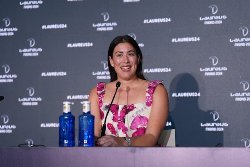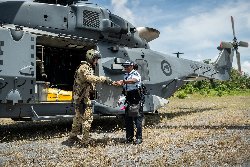Cablegate: October Sitrep On Nigerian Polio Eradication Efforts
VZCZCXRO7994
PP RUEHMA RUEHPA
DE RUEHUJA #2129/01 3031221
ZNR UUUUU ZZH
P 291221Z OCT 08
FM AMEMBASSY ABUJA
TO RUEHC/SECSTATE WASHDC PRIORITY 4302
INFO RUEHOS/AMCONSUL LAGOS 0158
RUEHZK/ECOWAS COLLECTIVE
RUEHPH/CDC ATLANTA GA
RUEAUSA/DEPT OF HHS WASHDC
UNCLAS SECTION 01 OF 03 ABUJA 002129
SENSITIVE
SIPDIS
DEPARTMENT FOR OES/IHA DANO WILUSZ
USAID FOR GH/HIDN ELLYN OGDEN, RICHARD GREENE
USAID FOR AFR/SD MARY HARVEY
CDC FOR NCIRD/GID/DEEB SUE GERBER
E.O. 12958: N/A
TAGS: TBIO KISL PGOV SOCI ECON KOCI EAID NI
SUBJECT: OCTOBER SITREP ON NIGERIAN POLIO ERADICATION EFFORTS
REF: A. STATE 102802
B. STATE 65054
C. ABUJA 1591
D. ABUJA 815
SENSITIVE BUT UNCLASSIFIED - DO NOT DISTRIBUTE OUTSIDE USG.
1. (U) Per reftel A action requests, U.S. Mission provides this
first in the new series of sitreps on the Nigerian government's
polio eradication efforts. We suggest this sitrep be read in
conjunction with refs C and D, which have previously reported on the
Mission's efforts on the polio epidemic in general and our advocacy
for eradication efforts in particular.
2. (SBU) Summary. U.S. Mission Nigeria Action Team on Polio held an
interagency meeting on October 9 to assess the current situation and
outline effective recommendations for addressing the growing concern
regarding the spread of polio in Nigeria. Although there are some
promising signs, the polio situation is still dire and requires
continued and coordinated efforts by all parties. Polio cases,
compared to this point in 2007, have more than tripled in 2008 from
223 to 740 in the 24 states. GON population projections from the
2006 census, underestimate the current actual population, making it
difficult for accurate assessments of eligible children reached and
those who remained unvaccinated at the end of each vaccination
campaign. The team agreed on the need for continued high level
engagement in country, within the region, and in Washington. It was
also agreed to focus on engaging Local Government Area (LGA)
Chairmen and State Health Commissioners and to launch a targeted
mass media campaign to boost awareness and social mobilization in
the northern states. The team will hold regular bi-weekly meetings
to monitor the situation and make recommendations as necessary.
Higher level advocacy efforts by the Chief of Mission will continue
as noted in refs B - D with Governors, Emirs, and the President,
including using opportunities to discuss polio at national forums or
Africa regional events. Additionally, U.S. Mission suggests that
Department push polio onto the agenda of all regional political
meetings. End Summary.
.
Current In-Country Polio Status
-------------------------------
.
3. (U) As of October 24, 740 polio cases have been recorded across
24 states in Nigeria in 2008. This compares with 229 cases in 21
states for the same time period in 2007. Kano State in the North
West Zone continues to lead the country with 263 cases (compared to
60 cases in 2007), followed by Zamfara State, also in the North West
Zone, with 83 cases (compared with five cases in 2007). Nigeria has
exported polio cases to at least three other countries in Africa so
far this year, namely the Republic of Niger, Benin Republic, and
Burkina Faso.
.
Frequency and Effectiveness of Vaccination Campaigns
--------------------------------------------- -------
.
4. (U) Supplemental Immunization Activities (SIAs) have been
conducted over the past several years, which involve the delivery of
OPV through a house-to-house strategy to all children under five.
In 2006 the SIA was modified to Immunization Plus Days (IPD)
strategy, which includes the delivery of OPV at fixed posts (usually
at a primary health clinic) and other child survival interventions
such as insecticide treated bednets, de-worming medicines, and
paracetamol syrup. While the strategy appears sound, the effect has
not yet been fully realized as quantities of injectible antigens and
add-ons are usually not in sufficient supply to match the target
group.
5. (U) Monitoring by GON and partner representatives during the
recent IPD mass campaign (August 23-26), reflect 94% coverage,
though this should be interpreted with caution as target figures
greatly underestimate the actual number of children under five. The
percentage of children missed during the last several campaigns
continues to hover around 6%. In Kano, during the August 2008
campaign, for example, 7% of children were reportedly not reached.
Forty-nine percent of those were due to non-compliance, 8% due to
households not visited, and 43% reportedly due to children's
absence. In November an Integrated Measles Campaign (IMC) is
planned to follow-up on the Measles campaigns held in December 2005
in Northern States, and December 2006 in Southern States.
Specifically, the campaign will be held in Northern States between
26-30 November and in Southern States between 10-14 December.
Integration of OPV and Vitamin A with measles vaccine are planned
during those efforts.
ABUJA 00002129 002 OF 003
6. (U) U.S. Mission notes that surveillance data, which are
generally considered to be the most reliable and representative, are
dramatically at odds with both the administrative and monitoring
data available. (Note: the surveillance data indicates children who
have shown sudden onset of paralysis. End Note). Despite having
conducted 17 rounds of immunization campaigns in Kano since 2006,
only 19% of children in the state are seen in the surveillance
system report as having been fully immunized with three or more OPV
doses. In addition, the surveillance system data indicate that 34%
of children from Kano State have never received polio vaccination.
This means the vast majority of children in Kano remains vulnerable
to one or more of the three types of polio and potentially
contributes to the disease's transmission. Moreover,
vaccine-derived polio virus continues to appear in at least nine
northern states. The Sultan of Sokoto, leader of Nigeria's Muslim
community, played a prominent role in administering OPV at the
launch of the most recent IPD. Similarly, traditional leaders such
as the Emir of Zazzau, the Executive Governors of Jigawa and Kebbi
States played visible and supportive advocacy roles in the August
campaign. However there are still some reservations with some state
officials and LGA chairmen in Kano State.
.
Upcoming Vaccination Campaigns and Challenges
---------------------------------------------
.
7. (SBU) The next polio round will be included within the Integrated
Measles Campaign (IMC), where children between 9-59 months will be
given measles vaccine, while those from 0-59 months and 6-59 months
will receive oral polio vaccine and vitamin A, respectively. The
IMC is scheduled for November 26-30 in the north and December 10-14
in the south. Separate polio campaigns in the interim are not
planned in the northern states, primarily due to lack of support
from the Nigeria's National Primary Health Care Development Agency
(NPHCDA) with the exception of outbreak mop-ups and Local
Immunization Days (LIDs), held in LGAs with low routine immunization
coverage.
8. (SBU) On October 17, the Executive Director of NPHCDA was
abruptly removed from her position and replaced by a senior
technical manager in the East Asia Division of the World Bank, Dr.
Mohammed Ali Pate, a move universally welcomed. The Minister of
Health convened a Joint Meeting of the Polio Eradication Initiative
Task Force (PEITF) and the ICC in Abuja on October 20-21, including
about a dozen state commissioners of health. The meeting provided a
venue for very frank discussions over current IPD results and
planning for the IMC. The USG, DFID, WHO and Rotary International
representatives spoke forcefully and succinctly highlighting the
need for effectiveness and measures of accountability for IPD
campaigns.
9. (U) Another major challenge is the lack of public information on
the spread of the virus leading to the mobilization of all sectors
to eradicate the disease. WHO Nigeria, one of the four implementing
partners of the Global Polio Eradication Initiative (WHO, CDC,
UNICEF, and Rotary International are the others) has recently
launched a useful monthly newsletter under the banner "Count Down to
Polio Eradication in Nigeria." The intended audience includes the
GON, implementing partners, health workers, public and private
sector organizations, and communities. The newsletter gives a
breakdown of the polio situation on a state-by-state basis and the
status of the polio eradication campaign and publicizes upcoming
polio-related events and serves as a platform to entice other
stakeholders to join the campaign. This needs to be augmented with
an a "thumbs up/thumbs down" type of advocacy tool for rating the
performance of individual states both to replicate best practices
and induce more action in the fight against polio. U.S. Mission, in
conjunction with other donor partners, is exploring the introduction
of such a tool through cooperation with a reputable local media
organization.
10. (U) Related to the public information deficit is the need for a
frank national communications and social mobilization review. While
a review in this area was led by UNICEF in July 2007, it did not
lead to a clear and specific plan of action for improving public
awareness and social mobilization. The review needs to be updated
by the FMOH, NPHCDA and development partners to enable the crafting
of a more effective social mobilization strategy. Administrative
obstacles and distractions within the GON are additional challenges
that need to be overcome if the fight against polio is to be
successful. These include overcoming the turf battles to date
between the NPHCDA directorate and the Polio Eradication Initiative
(PEI) Task Force -- the appointment of a new Executive Director for
NPHCD is a step in the right direction. In addition, bureaucratic
delays at the state and local government levels on the release of
ABUJA 00002129 003 OF 003
financial resources need to be overcome. Finally, there needs to be
much better engagement with the GON Millennium Development Goals
Office, which has recently emerged as a major funder of PEI
activities. U.S. Mission will continue to discuss ways to overcome
these challenges with appropriate GON interlocutors.
.
The Role of Religious, Traditional and Elected Leaders
--------------------------------------------- ---------
.
11. (U) Engagement of religious, traditional and elected leaders at
all levels of government is increasing. As noted above, the Sultan
of Sokoto, Nigeria's titular Islamic leader, publicly participated
in the August immunization round by commissioning the campaign in
Sokoto State and overseeing vaccination of children with OPV at his
palace. Other traditional leaders, including the Emir of Kano, the
Emir of Zazzau, and the Emir of Ilorin (who immunized his recently
born twins in a public forum) and several Governors of Northern
States (i.e. Jigawa, Kebbi, Kwara, and Niger) are taking a more
public and active role in increasing immunization acceptance in
their respective states. Challenges remain at the local level where
LGA chairmen need to play a more active role in eradication efforts.
LGA chairmen need to demand better accountability from immunization
teams in their territory, introduce performance evaluations into
hiring decisions for PEI activities, and demonstrate leadership
through personal involvement in the IPDs. (Note: The Ambassador
and Mission Polio Action Team are encouraging all USG officials
visiting affected Nigerian states to pay courtesy calls on state
commissioners of local government and LGA chairmen and encourage a
more concerted effort within their respective administrative
purview. End Note).
.
Comments and Recommendations
----------------------------
.
12. (SBU) Advocacy by the Ambassador, other Mission officers and the
international donor community (including through the May 25 WHO
resolution) with a range of Nigerian officials right up to the level
of President Yar'Adua (ref c) have helped drive home the point that
Nigeria must take immediate and sustained action to eradicate polio.
There have been some promising responses by the GON, but as yet no
sustained follow-through. This is due in part to factors related to
the broader political challenges facing the Yar'Adua Administration
and is reflected in press stories criticizing the lack of progress
on many priorities.
13. (U) The Mission will continue its advocacy efforts and intends
to look for ways to encourage greater accountability from State
Commissioners of Health and the state branches of NPHCDA, which are
responsible for routine immunizations and play a critical role in
implementing polio mass vaccination campaigns. The Mission also is
deploying several senior staff from CDC and AID to continuously
follow-up the situation on the ground in the northern states.
Quicker disbursements of program funds at the state and local
government levels are essential and post will advocate this at the
federal level. We will also encourage targeted mass media campaigns
(radio, TV, and print media) to build community awareness about
vaccine preventable diseases in general and polio in particular.
U.S. Mission is also promoting increased advocacy efforts with new
partners such as the Gates Foundation and recommends that these be
increased strategically to match bilateral and multilateral efforts.
Advocacy work by OES, AID, and CDC with Washington offices of key
partners such as UNICEF and WHO is recommended to increase the
responsiveness of their respective country missions, and the
Department can help to place polio eradication onto the agenda of
international political meetings.
14. (U) This cable has been coordinated with Consulate Lagos.
SANDERS


 UN News: Healing Page By Page In Earthquake-affected Türkiye
UN News: Healing Page By Page In Earthquake-affected Türkiye Save The Children: Rate Of Attacks On Healthcare in Gaza Higher Than In Any Other Conflict Since 2018
Save The Children: Rate Of Attacks On Healthcare in Gaza Higher Than In Any Other Conflict Since 2018 UN News: Green Light For New Cholera Vaccine, Ukraine Attacks Condemned, Action Against Racism
UN News: Green Light For New Cholera Vaccine, Ukraine Attacks Condemned, Action Against Racism Laureus: Grand Slam Champion Garbiñe Muguruza Announces Retirement Ahead Of Laureus World Sports Awards
Laureus: Grand Slam Champion Garbiñe Muguruza Announces Retirement Ahead Of Laureus World Sports Awards Carbon Market Watch: Going For Green - Is The Paris Olympics Winning The Race Against The Climate Clock?
Carbon Market Watch: Going For Green - Is The Paris Olympics Winning The Race Against The Climate Clock? New Zealand Defence Force: NZDF Working With Pacific Neighbours To Support Solomon Islands Election
New Zealand Defence Force: NZDF Working With Pacific Neighbours To Support Solomon Islands Election